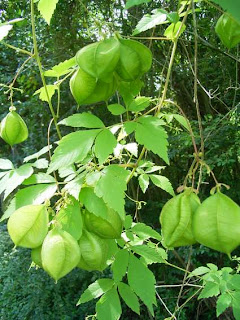




Botanical Name : Cardiospermum halicacabum
Family: Sapindaceae.
Balloon Vine, is a half hardy perennial, though gardeners often treat it as a half hardy annual which can grow up to 4m height. It is native to tropical areas in Asia, America, West Indies and Africa. Balloon vine is an attractive vine for fences or trellises with its dark green foliage and its pretty insignificant white flowers followed by large paper husk seed pods that look like balloons filled with air. Inside each pod are three pea-like seeds. As the seeds ripen, the soft green balloons turn brown and papery until they are light enough to fly away on the wind or float on water. The plant is also called "heartpea", "heartseed", "winter cherry" and "love in a puff," because the dark seeds carry a pretty, heart-shaped mark where they were attached to the pod.
How to grow
If planning to grow Balloon vine outdoors it is best to sow out the seed after the last frost of spring at a depth of 12mm into well drained soil. If you plan to grow the seedlings indoors first then the seed should be planted about 8 weeks before it is due to be planted out in the middle of spring. Germination of balloon vine should take place at about 20 degree Celcius and takes from three to four weeks. Seedlings should be transplanted into a sunny area of the garden at a spacing of around 60cm. The plant require a trellis for support and frequent watering to promote growth.
Medical Uses
The medical uses of the plant is widely used in Thailand. Its Thai name is "
Leaf: antiasthmatic, diuretic. Leaf juice: cough remedy. Stem: antipyretic. Flower or leaf juice: increases menstrual discharge. Fruit: crush with small amount of water and apply to relieve burns. Whole plant: antiasthmatic; treatment of arthritis Balloon vine's leaf extract possesses hypotensive and anti-inflammatory properties.
No comments:
Post a Comment